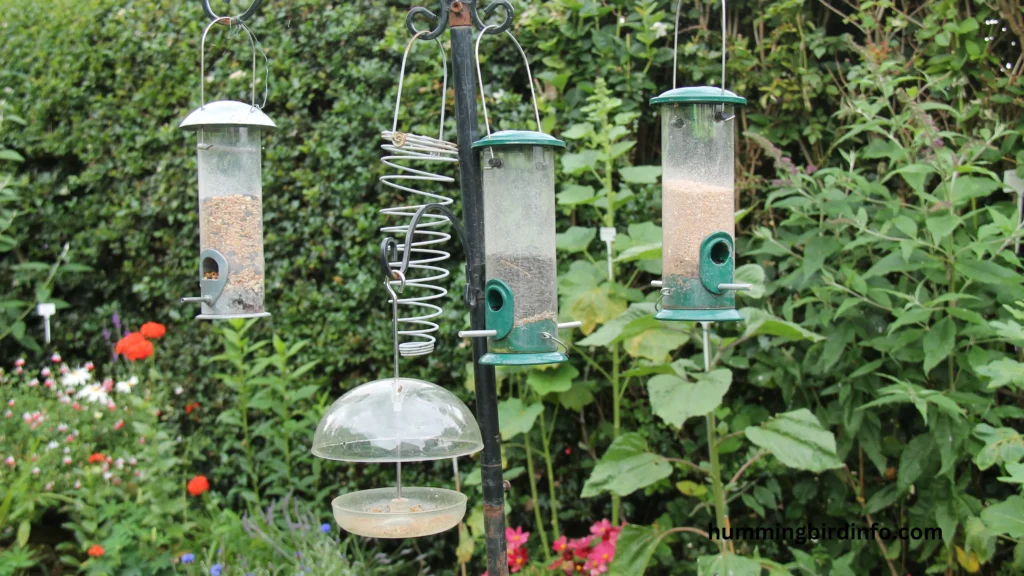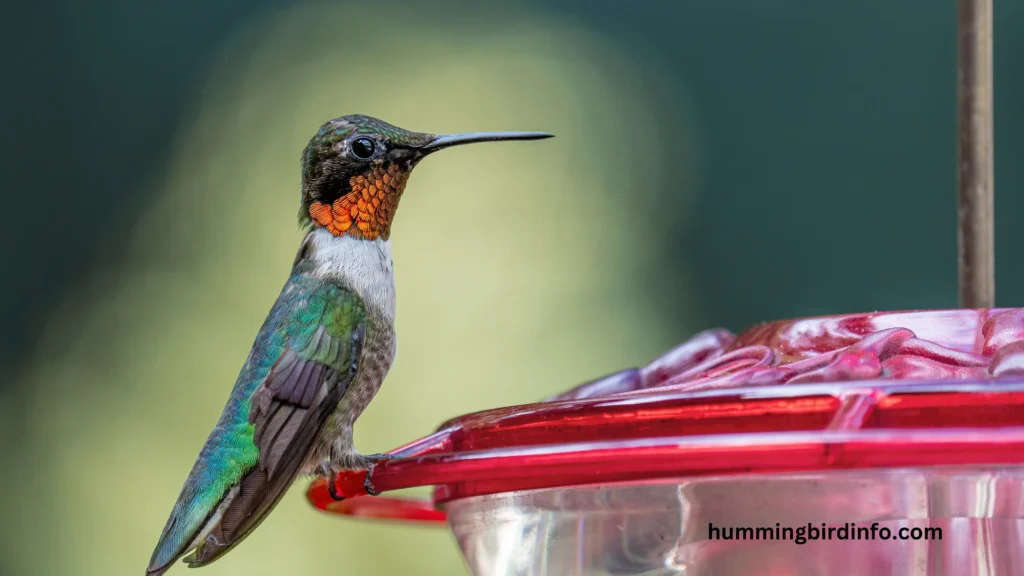There’s something magical about a hummingbird darting through a beam of sunlight, its iridescent feathers glinting like jewels in midair.
Gardeners and bird lovers alike wait eagerly each season, sugar water at the ready, hoping to attract these tiny wonders with well-placed feeders. Conventional advice often suggests placing feeders in the shade to protect the nectar—but is that always the best idea?
Hummingbird feeders serve a vital role, especially during migration or when natural nectar sources are limited. They’re more than just pretty decorations—they’re lifelines for birds needing quick energy, and windows of joy for those watching from inside.
But the question of where to place them—shade or sun—deserves a second look.
This post dives into the less-discussed side of that debate: the case for placing hummingbird feeders in sunny spots. While shade has benefits, sunlight may offer surprising advantages.
From increased visibility to natural warmth, some factors make the sun a worthy contender—especially when supported by smart feeder care. Let’s explore the five key reasons why the sun might be your feeder’s best friend and how to manage it responsibly.
Contents
- 1 Enhanced Visibility and Attraction
- 2 Potential Benefits of Warmth and Reduced Humidity
- 3 Addressing Concerns About Spoilage and Heat
- 4 Practical Considerations for Sunny Feeder Placement
- 5 Managing Sun Exposure Through Strategic Placement
- 6 Conclusion
- 7 FAQs
- 8 1. Can I put my hummingbird feeder in full sun all day?
- 9 2. Will the nectar spoil faster in the sun?
- 10 3. How do I know if the nectar has gone bad?
- 11 4. Are there specific feeders better for sunny spots?
- 12 5. How often should I clean a sunny feeder?
- 13 6. Can I hang multiple feeders in different spots?
Enhanced Visibility and Attraction
Hummingbirds are drawn to bright, vibrant colors, especially red—the color most feeders are designed around. Their sharp vision allows them to spot colors and movement from impressive distances.
Feeders placed in full sun reflect light and enhance their visibility, making them easier for birds to detect. A sunlit feeder may shine like a beacon, catching the attention of both resident hummers and passing migrants.
In nature, many nectar-rich flowers thrive in sunlight. By mimicking these environments, a sunny feeder may feel more “natural” to a hummingbird than one tucked deep into the shade.
Sunlight also enhances the viewing experience for humans. Better lighting means you can more clearly see and enjoy the hummingbirds, whether you’re snapping a photo or simply enjoying their antics from your window.
Especially during migration seasons, when young or traveling birds are actively searching for food, a bright feeder in a sunlit clearing can be a lifesaving signal amid green foliage and shadows.

Potential Benefits of Warmth and Reduced Humidity
In humid climates, shaded feeders can become breeding grounds for mold and bacteria. A bit of sunlight can speed up evaporation, reducing unwanted moisture around feeder ports.
In cooler seasons or regions, sunlight helps slightly warm the nectar, making it more appealing to cold or sluggish birds in the early morning or during chilly transitions between seasons.
Natural warmth may offer an energy boost to hummingbirds arriving after long flights. It’s not a substitute for fresh nectar, but sunlight can complement it when managed correctly.
Though minimal, UV light from the sun has limited antimicrobial effects. While this doesn’t replace regular cleaning, it might offer a slight edge in keeping feeders cleaner in especially humid or wet areas.
Rain can leave feeders wet and messy. Sunny locations dry more quickly, minimizing water accumulation that might dilute nectar or encourage bacterial growth in and around the feeder.
Addressing Concerns About Spoilage and Heat
The biggest downside of sun exposure is faster nectar spoilage. But with proper maintenance, feeders in the sun can remain just as safe as those in the shade.
Start with frequent cleaning. In hot weather, clean and refill your feeder every 1–2 days. In milder temperatures, every 3–4 days works. This prevents fermentation, mold, and bacteria.
Use smaller feeders in sunny areas so hummingbirds finish the nectar quickly before it turns. Don’t overfill if hummingbird traffic is light; this limits waste and minimizes spoilage risk.
Stick to a simple sugar-water recipe—¼ cup sugar per 1 cup water. Avoid adding food coloring or preservatives, which can harm birds. Keep it pure and clean, especially in warm sun.
Watch for signs of spoilage: cloudiness, black specks, or hummingbirds avoiding the feeder. If any of these show up, clean it immediately and replace with fresh nectar.
Choose feeder designs that ventilate well and are made of lighter-colored plastic. These absorb less heat than dark ones, helping to prevent overheating in direct sunlight.
Practical Considerations for Sunny Feeder Placement
Not all sun is created equal—morning sunlight is gentler and less likely to cause nectar spoilage than intense afternoon heat. Choose east-facing locations to capture this early warmth.
Consider spots with partial sun, where your feeder gets 3–4 hours of light, then natural shade. This helps you get the visibility benefits without compromising nectar quality.
Place feeders near a water source—like a shallow birdbath—so birds can drink or cool down. This is especially helpful when evaporation causes nectar to become more concentrated.
Sun-exposed spots may also be windier, which can help reduce overheating and deter flying insects. However, be sure your feeder is stable and won’t sway too much.
Don’t hesitate to experiment with different spots in your yard. Keep an eye on where birds visit most and how long nectar lasts in each location. Observation leads to smarter decisions.

Managing Sun Exposure Through Strategic Placement
Finding a balance between light and protection is often the sweet spot. You don’t have to pick between full sun and full shade—strategic placement makes a big difference.
A feeder that gets sunlight from dawn to mid-morning, then shade the rest of the day, offers both visibility and temperature moderation. This is ideal in most climates.
Use existing landscape features like trees, trellises, fences, or umbrellas to partially shield the feeder during the hottest hours. This reduces the risk of excessive heat buildup.
Placing feeders under an awning or overhang that allows dappled light is another smart solution. Birds still find it easily, and your nectar stays fresher longer.
If you have multiple feeders, test different locations to see which one attracts the most activity and stays safest. Every yard has its own microclimates and light patterns.
In the end, it’s not about choosing sun or shade—it’s about creating an environment that supports healthy feeding while attracting and delighting these energetic flyers.
Conclusion
While traditional wisdom leans toward shade, there are valid, science-backed reasons to consider placing hummingbird feeders in sunny spots—especially with proper care and attention.
The sun provides greater visibility, slight warming during cool mornings, and even helps reduce excess moisture. In the right conditions, it may actually help attract more hummingbirds.
That said, sunlight increases spoilage risk, so it demands more frequent cleaning. But even in the shade, neglect will do more harm than sun ever could.
The key is to stay observant, clean diligently, and test what works in your specific yard. The best feeder location is the one that keeps nectar fresh and brings hummingbirds fluttering in daily.
With smart placement and a little trial and error, your sunny feeder could become the busiest café in the garden—a place of beauty, life, and nonstop aerial ballet.
FAQs
1. Can I put my hummingbird feeder in full sun all day?
Yes, but you’ll need to change the nectar more frequently, especially in hot weather. If possible, aim for morning sun and afternoon shade.
2. Will the nectar spoil faster in the sun?
Yes, heat speeds up fermentation. But with daily maintenance, spoilage can be minimized or prevented.
3. How do I know if the nectar has gone bad?
Check for cloudiness, dark flecks, or off smells. Also, if hummingbirds avoid it, that’s a clear sign to clean and refill.
4. Are there specific feeders better for sunny spots?
Yes, use lighter-colored feeders made of clear plastic or glass. They absorb less heat and are easier to monitor for spoilage.
5. How often should I clean a sunny feeder?
In hot conditions, clean and refill every 1–2 days. In cooler temps, every 3–4 days is sufficient.
6. Can I hang multiple feeders in different spots?
Absolutely! This lets you test various locations and find out where birds gather most. It also reduces competition among territorial hummers.








